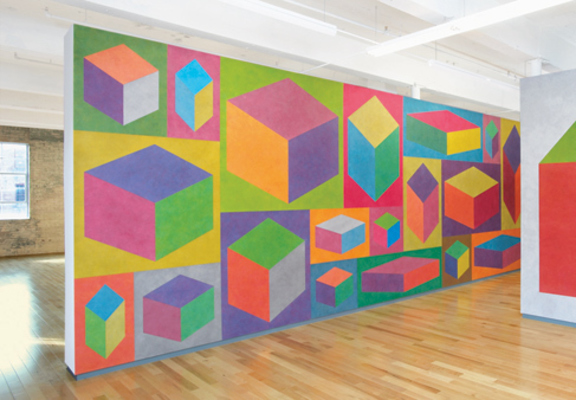
Description
Wall Drawing 766 was one of several new works unveiled at the 1994 Sol LeWitt retrospective at RENN Espace in Paris. LeWitt had begun to work in ink washes in 1982, and this later example of his work in this medium particularly shows the range of hues that he achieved through combining the four colors that form his vocabulary: black, yellow, red, and blue.
The cube has been of interest to LeWitt throughout his career, both in sculpture where it formed the basic unit of his permutations, and in his wall drawings in which the square has always figured prominently. The rendering of these cubes, while employing a method of perspective, is not meant to suggest any kind of spatial recession. Instead of drafting his forms using linear perspective, LeWitt drafts them isometrically, a technique in which the cubes are effectually tilted toward the viewer to indicate the volumetric nature of the shapes without compromising the flatness of the wall with any kind of architectural illusionism.
The dimensions of the cubes reflect the boxes of the grid in which they are situated. The grid, a fundamental tool that LeWitt has used to organize his walls in most of his drawings, is distorted: stretched and pulled in order to create this irregular pattern of rectangles. The cubes inside the grid stretch or pull in response to the distortion of the squares.
Backstory
While in Italy, Sol LeWitt would have had access to Trecento and Quattrocento frescoes such as the Arena Chapel in Padua, a famous fresco cycle by the Early Renaissance master Giotto di Bondone. LeWitt acknowledges the influence of these painted walls on his own drawings, and goes so far as to write in a letter to Andrea Miller-Keller, curator at the Wadsworth Atheneum in Hartford, Connecticut, that in his work he strives “to produce something [he] would not be ashamed to show Giotto.”1
1 Sol LeWitt and Andrea Miller-Keller. 1981-1983. Sol LeWitt Critical Texts, AEIUO, Incontri Internazionali D'Arte, Rome, Italy, editing by Adachiara Zevi, 1995
Details
- Work Date:
- September 1994
- Medium:
- Color ink wash
- Credit Line:
- San Francisco Museum of Modern Art, Accessions Committee Fund: gift of Barbara and Gerson Bakar, Emily Carroll and Thomas Weisel, Jean and James E. Douglas, Jr., Evelyn D. Haas, the Modern Art Council, Phyllis and Stuart G. Moldaw, Robin Wright Moll, Norah and Norman Stone, Danielle and Brooks Walker Jr., and Judy and John Webb. 2000.301